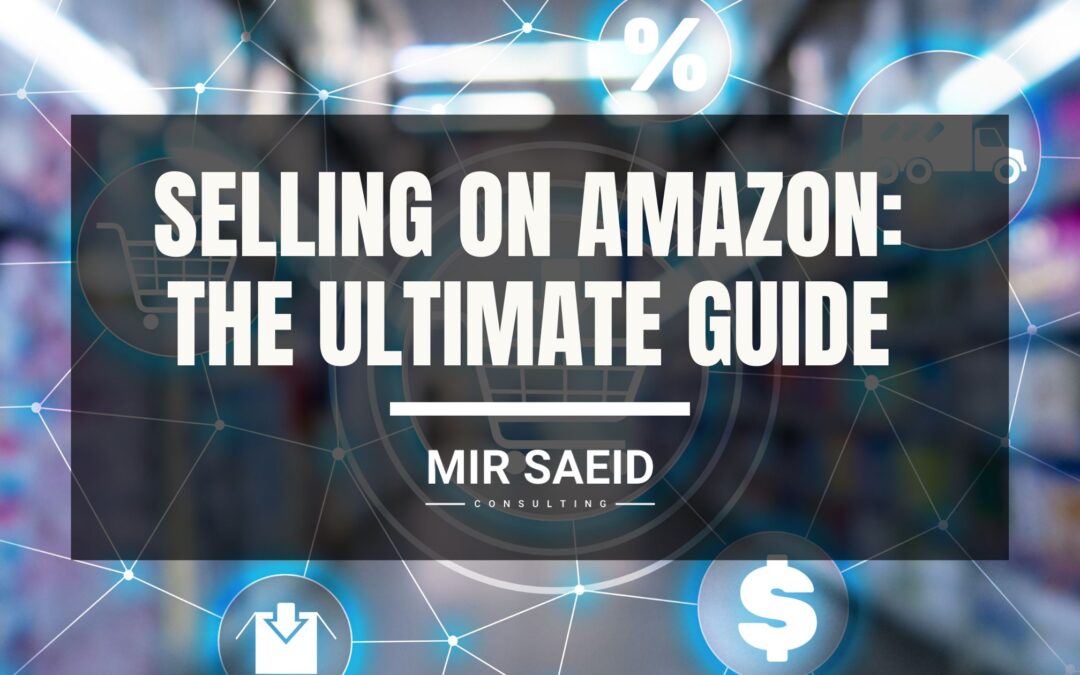There is a huge availability of information regarding selling online in United States marketplaces particularly Amazon and very little information about selling in other states. This blog is written for Canadian sellers. We aim to provide a step-by-step guide to the Canadian seller population regarding how to sell on Amazon.ca
You should know as of now 166.8 million visits have been paid to Amazon.ca and almost $ 1 billion of revenue is made annually. Meaning, a great opportunity for those in the North. The sellers who have an established e-commerce business, a great idea for a new product, or just have a passion for selling, here is how to take that next step with Amazon.ca.
Click to seek my Digital Marketing Consultancy.
Sign Up for an Amazon Seller Account to Sell on Amazon
This section will tell you about how to sign up for an Amazon Seller Account in Canada. It will tell you about the plans that are provided by the Amazon. With this type of plan comes the flexibility to sell one or many items. You only need to decide regarding the plans.
There are two plans namely individual and professional. The information regarding these plans is given below.
Individual
1. You have to pay $1.49 per sale
2. You can sell fewer than 30 items a month.
3. You do not need advanced tools or programs.
4. Not able to decide on particular selling products.
Professional
1. You have to pay $29.99 per month.
2. You can sell more than 30 items a month.
3. You can have API and other selling reports.
4. You can access Launchpad and Handmade.
- After choosing the plan for your e-commerce business, you are supposed to provide the following information to register your account:
- Bank account number and bank routing number
- Chargeable credit card
- Government-issued national ID
- Tax information
- Phone number
Signing up on Amazon.ca also involves the following steps:
Step 1: Go to the ‘Start selling online’ page and click on Sign up.
Step 2: Provide the email and password for the account for the creation of a new Amazon account.
Step 3: Enter Information regarding business location and select business type. The next few steps include entering your individual information, including:
- Your physical address
- Phone number
- DOB
- Billing and bank account information
- Store name and selling plan
Once you enter all of this required information, Amazon will need to verify your account before they approve your account to sell. Once approved, you can start listing items for sale.
Also see: How to Make Passive Income on Amazon?
Know About the Fulfillment Methods
Two fulfillment methods are there that you should know about and choose between them.
Fullfilment by Amazon
FBA which stands for Fulfilment by Amazon is a service that allows you to sell your products on the platforms of Amazon while Amazon takes care of the logistics of fulfillment, including picking, packing, and shipping your goods from their fulfillment centers to the customers.
For your day-to-day business operations, you have to pay small fees to Amazon and they will handle all the logistical aspects of your business. This will allow you to focus your energy on upgrading your business, particularly letting your brand grow.
What happens is this:
- The inventory of goods is shared by a seller to Amazon Fulfillment Centre.
- Amazon receives the products, sorts them, and then stores them.
- The customer puts an order for your product.
- After the order is placed, Amazon picks it, packs it then ships it to the customer.
- Customer service is taken care of by Amazon, including the return policy.
One thing that you should note is that you are utilizing the power of Amazon when it comes to making sales, it’s convenient and you won’t have to contend with any Post Office queues or fights with bubble wrap and sell tape!
However, you should be ready with:
- Your products. Based upon the rigorous research you should know what to sell to your customers and then source it to Amazon FBA.
- Updated inventory. Always keep your stock inventory updated. You should ensure your stocks are replenished from time to time.
- Product lists with the best marketing strategy. Amazon is huge but you will still need to write effective product listings and titles and market your products so that people can find them.
Also read: What is an Amazon FBA Coach?
Fulfillment by Merchant
FBM means that the seller will manage his or her own storage, fulfillment, and customer service. Some sellers prefer to use FBM because they can save money by avoiding FBA fees and inbound shipping costs. Many FBM sellers use a third-party fulfillment service provider to store and ship their products.
For a more in-depth comparison of these fulfillment methods, please check out our FBA vs FBM Comparison Guide. One more method that can be of use to you known as drop shipping is in stock. On the contrary, the items are purchased from a third party and shipped directly to the customer. Consequently, the seller does not handle the product directly.
The main point of distinguishing between dropshipping and FBA is the seller is not required to stock or own an inventory. He or she purchases from a third party and sells it forward.
Dropshipping works like this:
- Your customer places an order using his phone or any other device.
- Your store sends the order to the supplier automatically.
- The dropshipping supplier prepares the order and forwards it.
- The order is shipped to the customer who placed it.
To know more about dropshipping and other methods of fulfilment you can click on the following link.
Selling Fees on Amazon Canada
You should know there are four types of fees on Amazon Canada. You do not have to pay them all but the one that is related to the products you sell on the platform.
1. Subscription Fee
This is regarding the plan you choose namely the individual one or the professional one. On the Professional selling plan, there is a flat fee of $29.99 per month and no per-item fee. On the Individual selling plan, there is a $1.49 fee for each item sold.
2. Selling Fees
These fees are charged per item sold, and they include referral fees and variable closing fees.
3. Shipping Fees
The shipping rates are charged based on the product category and shipping service selected by the buyer.
4. FBA Fees
For products that Amazon fulfills for you (known as Fulfilment by Amazon, or FBA), there are fees for order fulfillment, storage, and optional services.
Tip: you can use the Seller App to track sales, fulfill orders, find products to sell, respond to customer questions, capture and edit professional-quality product photos, and create listings from your phone. You do not require an office for this and can do this from anywhere.
Tax Regulation in Canada
As you know selling goods in Canada or anywhere around the world may be subject to collecting and paying federal sales tax in the form of GST or HST) on your sales.
There are two main types of sales taxes in Canada:
1. Federal Sales Tax
This is also known as the Goods and Services Tax (GST) or Harmonized Sales Tax (HST). these are administered jointly. Whether you’re charged for HST or GST depends on the particular province or territory you operate your business in. However, you may be liable for the taxes even if your business is not registered in Canada.
2. Provincial Sales Tax
Also known as the Quebec sales tax (QST), or Retail Sales Tax (RST). Whether PST, RST, or QST applies depends on the business’s particular province.
Below given table tells you about the tax rates applicable in the province you are working.
| Sales Tax Type | Provinces/Territories |
| GST Only | Alberta (5% GST)Nunavut (5% GST)Northwest Territories (5% GST)Yukon (5% GST) |
| GST and PST/RST/QST | British Columbia (5% GST + 7% PST)Manitoba (5% GST + 7% RST)Quebec (5% GST + 9.975% QST)Saskatchewan (5% GST + 6% PST) |
| HST Only | Ontario (13%)New Brunswick (15%)Newfoundland (15%)Nova Scotia (15%)Prince Edward Island (15%) |
There are different tax obligations for Canadian sellers than for sellers in the US. Canada collects GST and HST. As mentioned above, Canadian sellers have different tax obligations than sellers in the U.S. Even if you are not a resident of Canada, you may be responsible for GST or HST. So before you list a product on Amazon.ca, make sure you are registered for GST or HST.
Tip: performance metrics matter. As sellers, you should have a high standard so you can provide a seamless, delightful shopping experience. You Can be customer-obsessed and keep an eye on this metric:
- Order defect rate (a measure of a seller’s customer service standards): < 1%
- Pre-fulfillment cancel rate (initiated by the seller before shipment): < 2.5%
- Late shipment rate (orders that ship after the expected date): < 4%
Sum Up
Besides these basic requirements, you also need to list your product on Amazon.ca and set up an inventory in Canada. To know how to list your products and set up inventory, read from our website. You also need to attract customers. There are several things you can do to attract customers, for instance, the Amazon Flywheel describes our method for driving growth. Do you have more questions about selling in Canada? Let us know in the comments below!
I along with my team help SMBs with all kinds of Digital Marketing Services.
Contact us today!
Looking for Kashmir Exclusives? Then head to Kashmirica where we curate products straight from the valley of Kashmir.
Read other blogs:
- What is Amazon KDP? The Complete Guide
- How To Start an Amazon FBA Business With Little Money?
- What Is An Amazon Brand Store?
- How Can You Sell Used Items on Amazon?
- Selling on Walmart vs Selling on Amazon
- How To Start Amazon Dropshipping in Canada?
- How To Use Amazon Attribution To Boost Sales?
- Amazon FBA or Dropshipping: Which one is Right for You?
- Selling Clothes on Amazon: Essentials

Mir is a British-educated Digital Marketing Expert with 10+ years of experience in the B2B, D2C, and eCommerce Industries. Having worked with 50+ startups and SMEs, he has a clear understanding of what it takes to establish growth on online platforms.
He is also the Founder of Kashmirica, a social impact brand that aims to take exclusives from Kashmir to the Global consumer. An enthusiastic cultural entrepreneur, Mir is driven by a passion to bring about a social impact.
An avid reader, he loves writing about marketing, and entrepreneurship.













